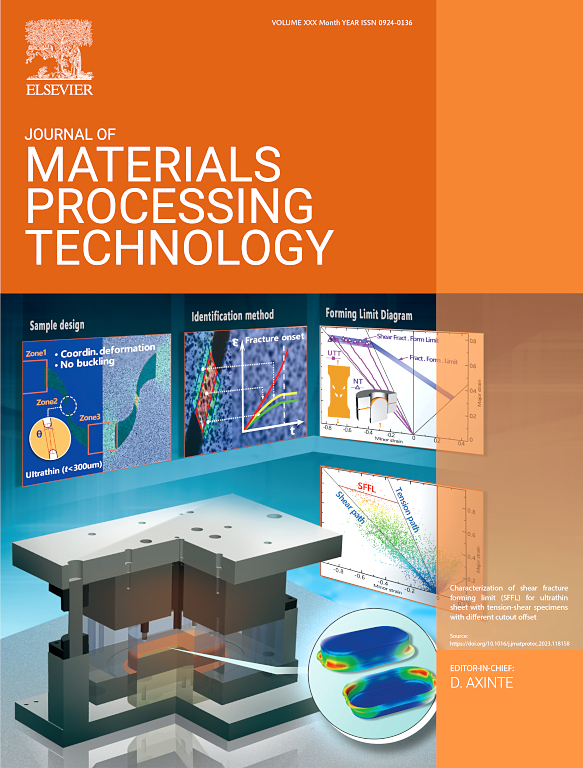Fundamental investigation on damage evolution and material removal anisotropic mechanism in monocrystal sapphire
IF 7.5
2区 材料科学
Q1 ENGINEERING, INDUSTRIAL
Journal of Materials Processing Technology
Pub Date : 2025-09-05
DOI:10.1016/j.jmatprotec.2025.119052
引用次数: 0
Abstract
Monocrystal sapphire curved surface optical components are widely used in various fields such as optical engineering, aerospace, and scientific research due to their superior optical performance and reliable mechanical properties. However, the processing of curved components involves multiple crystal planes of sapphire (including the A, M, N, C, and R planes), and the anisotropic characteristics of material removal and damage evolution on each crystal plane have become an issue that urgently needs to be addressed. In this study, for the first time, single-abrasive scratch experiments were systematically performed on all sapphire crystal planes (A, M, N, C, R), and the crystal-orientation dependence of material removal was directly revealed through analysis of scratch morphology and force. An innovative analytical approach was developed that combines elastic stress field modeling with slip/twinning and cleavage activation probabilities to evaluate the anisotropic characteristics of damage evolution in monocrystal sapphire. Finally, transmission electron microscopy was used to characterize subsurface damage within the scratch grooves, and, based on the relationship between dislocations and cracks, the orientation dependence of damage evolution was further elucidated. We developed an innovative analytical approach that combines elastic stress field modeling with slip/twinning and cleavage activation probabilities to quantitatively assess the anisotropic characteristics of damage evolution in monocrystalline sapphire. The results indicate that the anisotropy in the material removal form of sapphire occurs during the brittle removal stage, with significant anisotropic characteristics manifested in the differences in brittle spalling shape and brittle spalling area. Furthermore, the distribution of the elastic stress field indicates that median cracks are induced by tensile stress during the loading process, while radial and lateral cracks are caused by tensile stress during the unloading process. Simultaneously, the degree of brittle fracture induced by scratching force, the stress field, and the probability of cleavage fracture activation follow the sequence R < N < C < M < A, whereas plasticity exhibits an inverse relationship with the activation probability of slip/twinning. The scratching of R plane is more conducive to the ductile machining due to its lower elastic stress and higher dislocation density. These findings provide valuable scientific insights and a solid theoretical foundation for advancing the processing of sapphire curved surface components.
单晶蓝宝石损伤演化及材料去除各向异性机制的基础研究
单晶蓝宝石曲面光学元件以其优越的光学性能和可靠的力学性能,广泛应用于光学工程、航空航天、科学研究等各个领域。然而,曲面构件的加工涉及蓝宝石的多个晶面(包括A、M、N、C、R等晶面),各晶面上材料去除和损伤演化的各向异性特性成为迫切需要解决的问题。本研究首次系统地对蓝宝石所有晶体平面(A、M、N、C、R)进行了单磨料划伤实验,并通过对划伤形貌和力的分析,直接揭示了材料去除的晶体取向依赖性。提出了一种将弹性应力场模型与滑移/孪生和解理激活概率相结合的分析方法,以评估单晶蓝宝石损伤演化的各向异性特征。最后,利用透射电子显微镜对划痕槽内的亚表面损伤进行了表征,并基于位错与裂纹之间的关系,进一步阐明了损伤演化的取向依赖性。我们开发了一种创新的分析方法,将弹性应力场建模与滑移/孪晶和解理激活概率相结合,定量评估单晶蓝宝石损伤演化的各向异性特征。结果表明:蓝宝石材料去除形态的各向异性发生在脆性去除阶段,在脆性剥落形态和脆性剥落面积上表现出明显的各向异性特征;弹性应力场分布表明,加载过程中拉应力诱发中间裂纹,卸载过程中拉应力诱发径向和侧向裂纹。同时,划伤力诱发脆性断裂的程度、应力场、解理断裂激活概率依次为R <; N <; C <; M <; A,而塑性与滑移/孪生激活概率呈反比关系。R面由于其较低的弹性应力和较高的位错密度,更有利于延性加工。这些发现为推进蓝宝石曲面部件的加工提供了有价值的科学见解和坚实的理论基础。
本文章由计算机程序翻译,如有差异,请以英文原文为准。
求助全文
约1分钟内获得全文
求助全文
来源期刊

Journal of Materials Processing Technology
工程技术-材料科学:综合
CiteScore
12.60
自引率
4.80%
发文量
403
审稿时长
29 days
期刊介绍:
The Journal of Materials Processing Technology covers the processing techniques used in manufacturing components from metals and other materials. The journal aims to publish full research papers of original, significant and rigorous work and so to contribute to increased production efficiency and improved component performance.
Areas of interest to the journal include:
• Casting, forming and machining
• Additive processing and joining technologies
• The evolution of material properties under the specific conditions met in manufacturing processes
• Surface engineering when it relates specifically to a manufacturing process
• Design and behavior of equipment and tools.
 求助内容:
求助内容: 应助结果提醒方式:
应助结果提醒方式:


